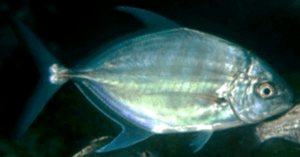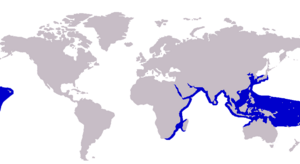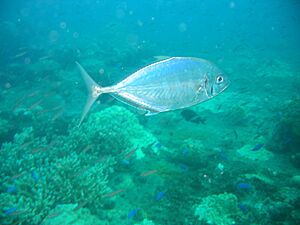Blue trevally facts for kids
Quick facts for kids Blue trevally |
|
|---|---|
 |
|
| Conservation status | |
| Scientific classification | |
 |
|
| Approximate range of the blue trevally | |
| Synonyms | |
|
The blue trevally (Carangoides ferdau) is a common and widespread fish. It is also known by other names like the banded trevally or Ferdau's trevally. This fish belongs to the jack family, called Carangidae. You can find blue trevally in tropical and subtropical waters. They live across the Indo-Pacific and central Pacific regions. This includes areas from South Africa all the way to Hawaii.
Blue trevally are medium-sized fish. They can grow up to 70 centimeters (about 27 inches) long. Their fins and colors help scientists identify them. These fish live in waters up to 60 meters (about 200 feet) deep. They like reefs, beaches, lagoons, and sandy areas. Blue trevally are predators, meaning they hunt other animals. They eat smaller fish, prawns, crabs, and molluscs. Not much is known about how they reproduce. People fish for blue trevally in many places. It is also a popular fish for sport fishing. Many people enjoy eating blue trevally because it tastes great.
Contents
What is the Blue Trevally and How is it Named?
The blue trevally is part of the Carangoides group of fish. This group includes many types of jacks and trevallies. The Carangoides genus is part of the larger Carangidae family. This family includes all jacks and horse mackerels. The Carangidae family belongs to the Carangiformes order of fish.
A Swedish scientist named Peter Forsskål first described this fish in 1775. He found a specimen in the Red Sea. He first named it Scomber ferdau. This name linked it to mackerels. Later, scientists created the Carangidae family. The fish was then moved to the Caranx genus. Finally, it was placed in the Carangoides genus, where it remains today. The name ferdau likely refers to the person who collected the first fish specimen.
What Does a Blue Trevally Look Like?
The blue trevally is a medium-sized fish. It can grow up to 70 centimeters (27 inches) long. It can also weigh up to 8 kilograms (17.6 pounds). Its body is somewhat flat and long, like a rectangle. The top part of its body is more rounded than the bottom.
Unlike many other trevallies, the blue trevally has a blunt, rounded snout. Its lips are also quite thick when it's an adult. It has two separate dorsal fins (on its back). The first dorsal fin has eight stiff spines. The second dorsal fin has one spine and 26 to 34 soft rays. This is more soft rays than any other fish in the Carangoides group. Young blue trevally have a curved second dorsal fin.
The anal fin (on its belly) has two spines that are separate at the front. Then it has one spine connected to 21 to 26 soft rays. The pelvic fins (on its underside) have one spine and 20 or 21 soft rays. The lateral line on its side has a gentle curve at the front. This line helps the fish sense movement in the water. The front part of the lateral line has 82 to 90 scales. The straight part has 12 to 17 scales and 26 to 31 tough plates called scutes.
The lower part of its chest is bare, without scales. However, there is a band of scales on the sides. The upper jaw can extend forward. It has narrow bands of small, brush-like teeth. These teeth become less noticeable as the fish gets older. The fish has 24 to 29 gill rakers, which help it filter food. It also has 24 vertebrae (backbones).
The top of the blue trevally's body is blue-green to yellow-green. Its belly is silvery. Adult fish often have five or six faint dark vertical bands. These bands usually stay visible even after the fish dies. You might also see many small, golden spots on its sides. These spots are mostly above its pectoral fins (side fins).
The soft dorsal and anal fins are pale yellowish-green. The front tips of these fins are often white or blue. The caudal fin (tail fin) is yellow-green. It has a dark edge and dark tips. The pelvic fins are whitish or clear.
Where Do Blue Trevally Live?
The blue trevally lives in many places around the world. It can be found in the tropical and subtropical waters of the Indian Ocean, West Pacific, and Central Pacific Oceans. Its range stretches from South Africa in the west. It goes north along the East African coast to the Red Sea. Then it spreads across to India and Southeast Asia.
The species also lives south in Australia and Indonesia. It can be found as far north as Japan. In the Pacific, it reaches Hawaii and many islands. These islands include Micronesia, New Caledonia, and Tonga.
Blue trevally live in coastal waters. They are found at depths up to 60 meters (about 200 feet). They prefer areas with reefs, beaches, lagoons, and sandy bottoms. These fish live in the open water, which allows them to move between islands and atolls. They are rarely found in estuaries (where rivers meet the sea). This suggests they don't do well in water that is not very salty.
How Do Blue Trevally Live and Are They Fished?
Scientists don't know much about the daily life and habits of the blue trevally. Most of what we know is about what they eat. Blue trevally are fast-swimming predators. They often swim in small schools. They eat a variety of small fish, like mackerel and filefish. They also eat crustaceans such as prawns, crabs, and sea lice. Soft molluscs and other soft prey are also part of their diet.
In Hawaii, blue trevally have been seen following other fish, like bonefish or goatfish. They eat any food scraps that these fish uncover while searching for food. Blue trevally seem to be common all year round. However, fish ready to reproduce are rarely seen. We don't have much information about how they reproduce or grow. But, young blue trevally larvae appear in the waters off Taiwan in February. This suggests they might lay their eggs around December. Young blue trevally sometimes hide among the tentacles of large jellyfish for protection.
Blue trevally are important for fishing in some areas. This is because there are many of them. Often, they are caught by accident when people are fishing for other types of fish. Statistics for blue trevally catches are not usually kept separately. They are often grouped with other trevallies. People catch them mainly with hooks and lines, gill nets, and various traps.
In South Africa, blue trevally are a popular gamefish. Anglers (people who fish with a rod and line) often catch them using small baits. The best times to catch them are usually at dawn and dusk. Blue trevally are considered excellent to eat. However, there have been rare reports of ciguatera poisoning from eating this fish.
See also
 In Spanish: Carangoides ferdau para niños
In Spanish: Carangoides ferdau para niños





